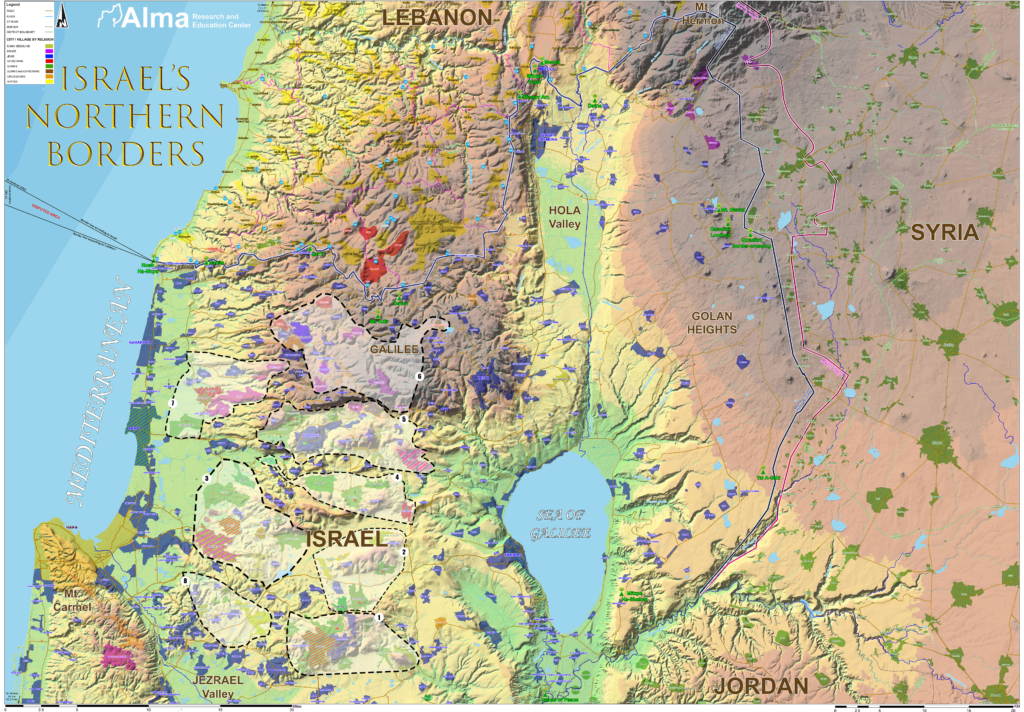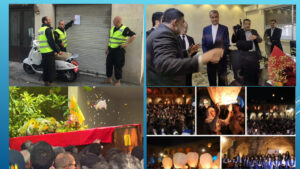By: Erez David Maisel, Brigadier (R)
The results of the 1948 – 1949 war formed the basic social structure of the Arab community in Israel. They influenced the pattern and pace of its evolving discourse, led by the then Arab political elite in Israel in the face of martial law (till 1966) and the fight for civil rights. Influenced by external factors, international (Soviet Union), and emerging regional Arab themes, the local Arab discourse was secular in character and bellicose in nature. This approach tended to marginalize the Arab political voice in Israel and served to sustain the legacy of the British mandate era regarding Arab Christian dominance and localize politicking. Physically, at the geographical level, the Arab communities in northern Israel developed into eight main residential clusters astride the four main Galilean routes (70, 77, 79, and 85), which influenced the economic and political development of the Arabs in northern Israel.
A review of the Arab demography in the Galilee exhibits the divide between the upper and lower Galilee. Upper Galilee though mainly Moslem Arab includes a large Chrisitan Arab and Druze population, compared to the lower Galilee, where Nazareth’s prominence is clear (with a Moslem Arab majority but a significant Christian presence) locally, but more importantly internationally, and it’s relative accessibility to the center of Israel.
In the western – lower Galilee, the five clusters are predominantly Arab Moslem (with a significant Christian presence):
The first (#1) is around the diversified city of Nazareth with its many Christian sites and Moslem majority (Christians, 21,700 and 56,200 Moslems) and includes the diversified city of Nof HaGalil (established in 1956 and named initially Upper Nazareth), currently with over 41,000 residents including ~18% Christian and ~10% Moslem Arabs and the rest Jews. The cluster includes seven Arab villages on an eastward spur (towards Mount Tabor) ending on route 65 (leading north to the nearby Golani Junction, converging with route 77). It includes Shibli-Umm al-Ghanam, a Bedu Moslem [1] town, and additional six Arab communities, totaling approximately 60,000 residents. The largest is Reineh, of 19,000 residents, of which about 15% are Christian Arabs. West of Nazareth, there are two additional Arab communities (Ilut of approximately 8,000 Moslem Arabs and the large town of Yafa an-Naseriyye, with over 19,000 residents of which approximately 18% are Christian Arabs).
A second major cluster (#2) is spread along route 77 (from Tiberias west). It includes Kfar Kanna at its center with over 20,000 residents, of which only 9% are currently Christian Arabs, and just north of the route (adjacent to Kfar Kanna) is Tur’an (with over 14,000 residents of which approximately 11% are Christian Arabs).
The third (#3) is located around the diversified city of Shfar’am, which includes 10,400 Christians, 26,000 Moslems, and 5,800 Druze[2]. Its eastern spur along route 70 includes the large Arab city of Tamra (44, 500 Moslems) and several additional large Arab towns like Kabul and I’billin with over 13,000 residents (of which 42% are Christians and includes a Bedu Moslem Moslem minority). A southern branch towards Kfar Manda (20,000 Arab Moslems) and Bir el-Maksur, a Bedu Moslem community of over 9,000 residents (many of them serving in the IDF).
A fourth eastern cluster (#4) is in the valley of Saknin, including the city of Sakhnin (30,6000 of which 5% are Christian Arabs), Arraba and Deir Hanna (in total approximately 40,000 Moslem Arabs and 1000 Christian Arabs) concluding in the town of Ilabun (with a Christian Arab majority of 4,000 and 2,000 Moslems).
The fifth cluster (#8 ), in the eastern outskirts of the Jezreel Valley, includes mainly Bedu Moslem residents in nine different villages, which is spread out between routes 70 and 77 (South from Nahalal northward to Shfar’am) and totaling over 28,000 residents (of which Zarzir and Basmat Tab’un are the largest, each with over 7,000 residents). The cluster includes a single Arab Moslem village, Ras Ali (with over 600 residents).

Three additional clusters in the western – upper Galilee are diversified and include a sizeable Druze population (~80% of total Druze population in Israel, 90,000 residents)[3]. The area historically served as the harbor city of Acre’s hinterland, a “mixed” city with over 49,000 residents, of which currently ~30% are Moslem Arabs. Acre (like many places in Israel) recently dealt with a severe wave of violence (following waves in 2000 and 2008) between local Arabs and Jews. This following the national elections to the Israeli parliament (Knesset) and during the IDF “Operation Guardian of the Walls” against the HAMAS in the Gaza strip[4]:
The first cluster in the western upper Galilee (#5) straddles route 85 (Acre – Safad road). With the city of Carmiel at its center stretches from Majd el-Krum (15,000 Arab Moslem residents), through Nahaf (13,000 Moslem residents), westward to Rameh (~8,000 residents including 50% Christian Arabs and 31% Druze), including Sajur (a Druze village of 4,000 residents). It ends in Maghar (23,000 residents, of which the majority are Druze and includes Christian and Moslem Arabs who are 21% each of the town’s makeup). The hometown of Arab Moslem member of the Israeli parliament, MK Mansour Abbas (leader of the Islamic Raam party) and currently supporting the current Israeli government.
A northern cluster (#6) coalesces around the city of Maalot – Tarshiha (a joint trilateral Jewish – Moslem – Christian municipality). It includes 21,000 residents (65% Jews and 10% Christian and Moslem Arabs, respectively, with a sizeable undesignated portion of the population). It includes north of Maalot – Tarshiha, the Christian village of Mi’ilya (over 3000 residents), a north-eastern spur leading to the Druze village of Hurfeish and Christian villages (Fassatu and Jish). A southern spur includes other Druze villages (Peki’in, Beit Jann, and Ein el Asad).
The southern cluster (# 7) along route 70 is known as the traditional seat of the Druze leadership (Tri-villages of Julis, Yarka, and Abu- Snan)[5]. Includes three major Arab communities starting in the SouthSouth at Jadeidi – Makr (21,000 Arab residents of which 7% are Christians), through Kfar Yasif (10,000 Arab residents of which half are Christians and 2% Druze) and Abu – Snan (14,000 residents of which half are Moslem Arabs, 15% Christians and 30% Druze).
Current demographic trends withstanding, the size of the total Arab population in the state of Israel is estimated to grow numerically by the year 2065 to 3.8 million, out of an estimated total Israeli population of 20 million (CBS. 2017). Conversely, estimations assess the proportion of the entire Arab population in Israel to remain at around 19%, due to the continued decline in Arab female fertility rates, especially for Moslem Arab females – which saw a dramatic reduction from annual highs of around 9% in the 60s to 3.16 in 2019. Christian Arab average fertility rates were generally much lower and have been stable for the last decade at around 2.0%[6]. Further, regarding the fertility rate amongst Moslem Arab females in the northern district, it continues to drop and is currently estimated at 2.51% (2.54% in the district of Haifa). This is in comparison to highs of 5.28% in the south amongst the Bedu Moslem tribes (CBS. 2021).
Accordingly, while the continued relative reduction of the size of the Arab population in the Galilee is expected to continue for the duration, the Arabs (predominantly Moslem) will continue to maintain a major presence in the eight residential clusters mentioned and is estimated by 2040 to amount to over a million Arab residents (around three million in 2065)[7]. The growing volume of Arab residents coupled with the youth bulge is generating two main trends which are worthy of special mention. A growing internal migration of a young northern Arab middle class to urban areas on the coast and in the Galilean hinterland[8] (including a growing trend of relocation to Jewish communities. Lack of housing (and development projects – currently being dealt with by the Israeli government), and improvement of quality and standard of living being prime movers but also the growing violence in Arab communities. The second being, a surge in the volume of idle young Arab men (predominantly Moslem males) – a global phenomenon named NEET (Not in Education, Employment, or Training)[9], which is a major enabler of criminal delinquency and inflaming violence in the Arab society (numbering currently over a hundred death for 2021). Additionally, the NEET demographic is a prospective participant in local self-organizing violence (inflamed by environmental circumstances and usually driven by mob dynamics), potentially driving organized civil disorder through their radicalization and recruitment to politically motivated organizations. A phenomenon noted during the last wave of violence in May 2021 which impacted all residents of the Galilee.
Brigadier General (IDF Reserves) Erez David Maisel has vast experience in strategic planning, international relations, and security diplomacy and is a hands-on practitioner in international conflict prevention and boundary management. A native of northern Israel he is co-founder of the Technion Institute in Haifa’s research center BRDG (Boundary Research and Deconfliction Group).
*Featured photo: Keshet Cave (Arc Cave), northern Israel – symbol for bridging divides (credit: EDM)
[1] Bedu Moslem are Arab Moslems who lived in the past a nomadic life. In popular culture they have been usually associated with merchant caravans and desert dwelling. Bedu Moslem tribes have populated the Galilee for decades, mainly leading a transitional lifestyle. In the last few years (with immense Israeli government support) the Galilean Bedu Moslem tribes have begun establishing Bedu Moslem towns. Many male tribal members volunteer to serve in the Israel Defense Force (IDF). [2]https://www.cbs.gov.il/he/mediarelease/Pages/2021/%D7%94%D7%90%D7%95%D7%9B%D7%9C%D7%95%D7%A1%D7%99%D7%99%D7%94-%D7%94%D7%93%D7%A8%D7%95%D7%96%D7%99%D7%AA-%D7%91%D7%99%D7%A9%D7%A8%D7%90%D7%9C-%D7%9C%D7%A7%D7%98-%D7%A0%D7%AA%D7%95%D7%A0%D7%99%D7%9D-%D7%9C%D7%A8%D7%92%D7%9C-%D7%97%D7%92-%D7%94%D7%A0%D7%91%D7%99%D7%90-%D7%A9%D7%95%D7%A2%D7%99%D7%99%D7%91.aspx
[4]https://votes24.bechirot.gov.il/.
[5] An additional influential Druze residential area includes the two large towns on mount Carmel (Isfiya and Daliyat al-Karmel) adjacent to Haifa with all its economic potential.
[7]https://economy.pmo.gov.il/CouncilActivity/Strategy/Pages/population2040.aspx
[8]https://www.themarker.com/markerweek/1.2801164.
[9]https://www.gov.il/he/departments/general/150320_challenge; https://en.idi.org.il/media/9319/neet-among-young-arabs-in-israel.pdf. The majority of young Israeli are automatically conscripted at the age of 18. The IDF then serves as a framework during the transition period (after matriculation) from school to the education and employment phase, assisting in the maturation and national socialization processes.






